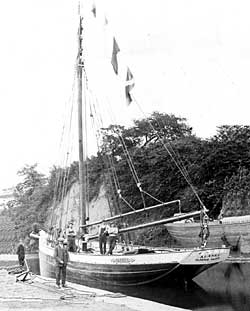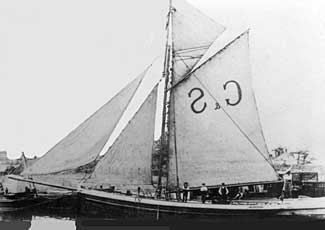The pilots of the
Bristol Channel and the River Severn played a vital role in ensuring
safe passage for ships approaching and leaving the entrance to the
canal at Sharpness. This page provides a brief introduction to that
role, and another page compiled by Alex Wood lists information about
individual pilots.
Trinity Pilots
In the
early days of the canal, pilotage in the Bristol Channel was controlled
from Bristol, and Trinity House licensed additional local pilots
for the very difficult tidal waters of the River Severn from King
Road (at the mouth of the Bristol Avon) to Sharpness. Each pilot
owned or shared a sailing cutter in which to go seeking incoming
ships needing guidance. Some would sail well down the channel, hoping
to meet a large ship that paid a high fee, but a Bristol pilot could
always claim precedence below King Road. This meant that ships on
their way to or from Gloucester often had to pay for two separate
pilots.
Gloucester Pilots
To escape the
control of Bristol, powers were obtained in 1861 to establish the
Gloucester Pilotage Board who appointed their own pilots to guide
ships in the Bristol Channel as well as in the Severn to and from
Sharpness. This encouraged pilots to cruise further down the channel,
competing with their colleagues to board the big ships. Most of
the Trinity Pilots continued under the changed arrangement, and
new applicants were required to serve an apprenticeship with an
experienced pilot and spend some time on deep sea vessels. To keep
their knowledge up-to-date, each pilot was required to carry out
regular surveys of the river at low tide. To distinguish to which
port they belonged, each Gloucester cutter was required to have
G&S displayed on its mainsail. Most of the pilots lived in the
small hamlets near Sharpness.
Notable Pilots
Thomas
Price (picture right) was in charge of the barque Director,
the first ship to enter the New Dock at Sharpness in 1874. His father
and his son were also pilots, covering over a century between them.
Albert Everett was specially commended
in 1883 for successfully piloting the 2,000 ton steamer Inchmaree
to Sharpness after the spring tides were past their peak. For completing
this tricky task, rather than let the ship discharge at Avonmouth,
the Sharpness merchants gave him an engraved silver cup and a purse
containing seven guineas.
Amalgamation
The competition
between pilots rewarded those who were adventurous and lucky, but
it was also wasteful of skilled resources, and in 1904 the pilots
formed their own company and changed over to taking ships in rotation.
Ten years later the Gloucester pilots combined with other pilots
in the Bristol Channel to maintain steam cutters at fixed locations,
and the sailing cutters were sold.
Pilotage Today
See the
Gloucester
Harbour Trustees website. |

Pilot Cutter Alaska

Pilot Cutter Veritas
.jpg)
Pilot Thomas Price (Photo: M Beynon) |